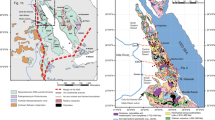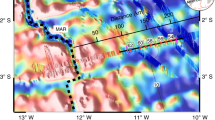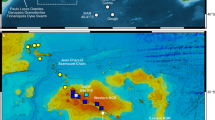Abstract
Three-quarters of the oceanic crust formed at fast-spreading ridges is composed of plutonic rocks whose mineral assemblages, textures and compositions record the history of melt transport and crystallization between the mantle and the sea floor. Despite the importance of these rocks, sampling them in situ is extremely challenging owing to the overlying dykes and lavas. This means that models for understanding the formation of the lower crust are based largely on geophysical studies1 and ancient analogues (ophiolites)2,3,4,5 that did not form at typical mid-ocean ridges. Here we describe cored intervals of primitive, modally layered gabbroic rocks from the lower plutonic crust formed at a fast-spreading ridge, sampled by the Integrated Ocean Drilling Program at the Hess Deep rift. Centimetre-scale, modally layered rocks, some of which have a strong layering-parallel foliation, confirm a long-held belief that such rocks are a key constituent of the lower oceanic crust formed at fast-spreading ridges3,6. Geochemical analysis of these primitive lower plutonic rocks—in combination with previous geochemical data for shallow-level plutonic rocks, sheeted dykes and lavas—provides the most completely constrained estimate of the bulk composition of fast-spreading oceanic crust so far. Simple crystallization models using this bulk crustal composition as the parental melt accurately predict the bulk composition of both the lavas and the plutonic rocks. However, the recovered plutonic rocks show early crystallization of orthopyroxene, which is not predicted by current models of melt extraction from the mantle7 and mid-ocean-ridge basalt differentiation8,9. The simplest explanation of this observation is that compositionally diverse melts are extracted from the mantle and partly crystallize before mixing to produce the more homogeneous magmas that erupt.
This is a preview of subscription content, access via your institution
Access options
Subscribe to this journal
Receive 51 print issues and online access
$199.00 per year
only $3.90 per issue
Buy this article
- Purchase on Springer Link
- Instant access to full article PDF
Prices may be subject to local taxes which are calculated during checkout



Similar content being viewed by others
References
Detrick, R. S. et al. Multichannel seismic imaging of a crustal magma chamber along the East Pacific Rise. Nature 326, 35–41 (1987)
Kelemen, P. B. & Aharanov, E. in Faulting and Magmatism at Mid-Ocean Ridges (eds Buck, W. R., Delaney, P. T., Karson, J. A. & Lagrabrielle, Y. ) 267–289 (Geophys. Monogr. Ser. 106, American Geophysical Union, 1998)
Pallister, J. S. & Hopson, C. A. Samail ophiolite plutonic suite: field relations, phase variation, cryptic variation and layering, and a model of a spreading ridge magma chamber. J. Geophys. Res. 86, 2593–2644 (1981)
Quick, J. E. & Denlinger, R. P. Ductile deformation and the origin of layered gabbro in ophiolites. J. Geophys. Res. 98, 14015–14027 (1993)
Boudier, F., Nicolas, A. & Ildefonse, B. Magma chambers in the Oman ophiolite: fed from the top and the bottom. Earth Planet. Sci. Lett. 144, 239–250 (1996)
Cann, J. R. A model for oceanic crustal structure developed. Geophys. J. R. Astron. Soc. 39, 169–187 (1974)
Kelemen, P. B., Shimizu, N. & Salters, V. J. M. Extraction of mid-ocean-ridge basalt from the upwelling mantle by focused flow of melt in dunite channels. Nature 375, 747–753 (1995)
Grove, T. L., Kinzler, R. J. & Bryan, W. B. in Mantle Flow and Melt Generation at Mid-Ocean Ridges (eds Phipps Morgan, J., Blackman, D. K. & Sinton, J. M. ) 281–311 (Geophys. Monogr. Ser. 71, American Geophysical Union, 1992)
O’Neill, H., St C & Jenner, F. E. The global pattern of trace-element distributions in ocean floor basalts. Nature 491, 698–704 (2012)
Nicolas, A., Boudier, F. & Ceuleneer, G. Mantle flow patterns and magma chambers at ocean ridges: evidence from the Oman ophiolite. Mar. Geophys. Res. 9, 293–310 (1988)
Francheteau, J. et al. 1 Ma East Pacific Rise oceanic crust and uppermost mantle exposed by rifting in Hess Deep (equatorial Pacific Ocean). Earth Planet. Sci. Lett. 101, 281–295 (1990)
Hékinian, R., Bideau, D., Francheteau, J., Lonsdale, P. & Blum, N. Petrology of the East Pacific Rise crust and upper mantle exposed in the Hess Deep (eastern equatorial Pacific). J. Geophys. Res. 98, 8069–8094 (1993)
Karson, J. A. et al. Structure of uppermost fast-spread oceanic crust exposed at the Hess Deep Rift: implications for subaxial processes at the East Pacific Rise. Geochem. Geophys. Geosyst. 3, 2001GC000155 (2002)
Lissenberg, C. J., MacLeod, C. J., Howard, K. A. & Godard, M. Pervasive reactive melt migration through fast-spreading lower oceanic crust (Hess Deep, equatorial Pacific Ocean). Earth Planet. Sci. Lett. 361, 436–447 (2013)
Gillis, K. M., Mével, C., Allan, J. (eds). Proc. Ocean Drilling Program, Initial Reports Vol. 147, 45–108 (Ocean Drilling Program, 1993)
McBirney, A. R. & Nicolas, A. The Skaergaard layered series. Part II. Magmatic flow and dynamic layering. J. Petrol. 38, 569–580 (1997)
Boudreau, A. E. & McBirney, A. R. The Skaergaard layered series. Part III. Non-dynamic layering. J. Petrol. 38, 1003–1020 (1997)
Naslund, H. R. & McBirney, A. R. in Layered Igneous Intrusions (ed. Cawthron, R. G. ) 1–43 (Dev. Petrol. 15, Elsevier, 1996)
Blackman, D. K. et al. Drilling constraints on lithospheric accretion and evolution at Atlantis Massif, Mid-Atlantic Ridge 30 degrees N. J. Geophys. Res. 116, B07103 (2011)
Henstock, T. J., Woods, A. W. & White, R. S. The accretion of oceanic crust by episodic sill intrusion. J. Geophys. Res. 98, 4143–4161 (1993)
Kinzler, R. J. & Grove, T. L. Primary magmas of mid-ocean ridge basalts. 2. Applications. J. Geophys. Res. 97, 6907–6926 (1992)
Ghiorso, M. S. & Sack, R. O. Chemical mass transfer in magmatic processes IV. A revised and internally consistent thermodynamic model for the interpolations of liquid-solid equilibria in magmatic systems at elevated temperatures and pressures. Contrib. Mineral. Petrol. 119, 197–212 (1995)
Danyushevsky, L. V. & Plechov, P. Petrolog3: integrated software for modeling crystallization processes. Geochem. Geophys. Geosyst. 12, Q07021 (2011)
Dick, H. J. B. & Natland, J. H. in Proc. Ocean Drilling Program, Scientific Results Vol. 147 (eds Mével, C., Gillis, K. N., Allan, J. F. & Meyer, P. S. ) 103–134 (Ocean Drilling Program, 1996)
Arai, S. & Matsukage, K. in Proc. Ocean Drilling Program, Scientific Results Vol. 147 (eds Mével, C., Gillis, K. N., Allan, J. F. & Meyer, P. S. ) 135–155 (Ocean Drilling Program, 1996)
Johnson, K. T. M., Dick, H. J. B. & Shimizu, N. Melting in the oceanic upper mantle: an ion microprobe study of diopsides in abyssal peridotites. J. Geophys. Res. 95, 2661–2678 (1990)
Langmuir, C. H., Klein, E. M. & Plank, T. in Mantle Flow and Melt Generation at Mid-Ocean Ridges (eds Phipps Morgan, J., Blackman, D. K. & Sinton, J. M. ) 183–280 (Geophys. Monogr. Ser. 71, American Geophysical Union, 1992)
O’Hara, M. J. Are ocean floor basalts primary magma? Nature 220, 683–686 (1968)
Grove, T. L. & Juster, T. C. Experimental investigations of low-Ca pyroxene stability and olivine pyroxene liquid equilibria at 1-Atm in natural basaltic and andesitic liquids. Contrib. Mineral. Petrol. 103, 287–305 (1989)
Stewart, M. A., Klein, E. M. & Karson, J. Geochemistry of dikes and lavas from the north wall of the Hess Deep Rift: insights into the four-dimensional character of crustal construction at fast-spreading mid-ocean ridges. J. Geophys. Res. 107, 2238 (2002)
Berndt, J., Koepke, J. & Holtz, F. An experimental investigation of the influence of water and oxygen fugacity on differentiation of MORB at 200 MPa. J. Petrol. 46, 135–167 (2005)
Saal, A. E., Hauir, E. H., Langmuir, C. H. & Perfit, M. R. Vapour undersaturation in primitive mid-ocean-ridge basalt and the volatile content of Earth’s upper mantle. Nature 419, 451–455 (2002)
Coogan, L. A., Gillis, K. M., MacLeod, C. J., Thompson, G. M. & Hékinian, R. Petrology and geochemistry of the lower ocean crust formed at the East Pacific Rise and exposed at Hess Deep: a synthesis and new results. Geochem. Geophys. Geosyst. 3, 8604 (2002)
Nilsson, K. Oxidation State, Sulfur Speciation, and Sulfur Concentration in Basaltic Magmas: Examples from Hess Deep and the Lau Basin 58. PhD thesis, Scripps Inst. Oceanogr., Univ. California. (1993)
Hanna, H. D. Geochemical Variations in Basaltic Glasses from an Incipient Rift and Upper Level Gabbros from Hess Deep, Eastern Equatorial Pacific 56, 57. MSc thesis, Duke Univ. (2004)
Natland, J. H. & Dick, H. J. B. Paired melt lenses at the East Pacific Rise and the pattern of melt flow through the gabbroic layer at a fast-spreading ridge. Lithos 112, 73–86 (2009)
Pedersen, R. B., Malpas, J. & Falloon, T. in Proc. Ocean Drilling Program, Scientific Results Vol. 147 (eds Mével, C., Gillis, K. N., Allan, J. F. & Meyer, P. S. ) 3–19 (Ocean Drilling Program, 1996)
Blum, N. Structure and Composition of Oceanic Crust and Upper Mantle Exposed in Hess Deep of the Galapagos Microplate (Equatorial East Pacific) 232–291. PhD thesis, Univ. Karlsruhe. (1991)
Nicolas, A., Boudier, F. & Ildefonse, B. Variable crustal thickness in the Oman ophiolite: implication for oceanic crust. J. Geophys. Res. 101, 17941–17950 (1996)
Kress, V. C. & Carmichael, I. S. E. Stoichiometry of iron oxidation reaction in silicate melts. Am. Min. 73, 1267–1274 (1988)
Ford, C. E., Russell, D. G., Craven, J. A. & Fisk, M. R. Olivine-liquid equilibria: temperature, pressure and composition dependence of the crystal/liquid cation partition coefficients for Mg, Fe2+, Ca and Mn. J. Petrol. 24, 256–266 (1983)
Danyushevsky, L. V. The effect of small amounts of H2O on crystallisation of mid-ocean ridge and backarc basin magmas. J. Volcanol. Geotherm. Res. 110, 265–280 (2001)
Beattie, P. Olivine-melt and orthopyroxene-melt equilibria. Contrib. Mineral. Petrol. 115, 103–111 (1993)
Ariskin, A. A., Frenkel, M. Y., Barmina, G. S. & Nielsen, R. L. COMAGMAT: a Fortran program to model magma differentiation processes. Comput. Geosci. 19, 1155–1170 (1993)
Ferrini, V. L. et al. Evidence of mass failure in the Hess Deep rift from multi-resolutional bathymetry data. Mar. Geol. 339, 13–21 (2013)
Acknowledgements
This research used samples and data provided by the IODP. We thank the USIO staff and the Siem Offshore crew for recovering hard rock core in an unsedimented environment at >4,850-m water depth, and for their invaluable assistance during the expedition. We gratefully acknowledge the contributions of the drilling proposal proponents and the leaders (C. MacLeod and D. Teagle) and participants of the site survey cruise (JC21) in making IODP Expedition 345 possible. We thank E. Klein and H. Dick for reviews.
Author information
Authors and Affiliations
Contributions
All authors were shipboard participants on IODP Expedition 345, contributed to the shipboard data collection, and discussed the results and their implications. K.M.G. wrote the first draft of the manuscript, K.M.G. and J.E.S. were co-chief scientists on the expedition, and A.K. was the staff scientist.
Corresponding author
Ethics declarations
Competing interests
The authors declare no competing financial interests.
Extended data figures and tables
Extended Data Figure 1 Summary lithostratigraphic columns of the gabbroic rocks recovered at IODP holes.
a, U1415I; b, U1415J; c, U1415P. Columns show recovery, lithological units, major rock types, dip of magmatic foliations and well-constrained magnetic remanence inclination values (mean and 1 s.d. listed). Lithological units were identified on the basis of similarities in rock types, magmatic textures and foliations. Palaeomagnetic remanence directions and the dip of the magmatic foliations and layers (not shown) for units II and III in holes U1415J and U1415P are most easily interpreted as blocks that probably formed by slumping and were rotated relative to each other. Ghost cores (G cores) are intervals drilled during hole cleaning operations. In a, Unit II refers to the Unit II layer gabbro series. d, Map showing the relative locations of holes U1415I, U1415J and U1415P; microbathymetry from ref. 45.
Extended Data Figure 2 Core images showing examples of simple, centimetre-scale modal layering and a moderate-to-strong magmatic foliation.
a, 345-U1415J-5R-2, piece 1, 2.0–17.5 cm; b, 345-U1415J-8R-2, piece 9, 105.5–121.0 cm.
Source data
Rights and permissions
About this article
Cite this article
Gillis, K., Snow, J., Klaus, A. et al. Primitive layered gabbros from fast-spreading lower oceanic crust. Nature 505, 204–207 (2014). https://doi.org/10.1038/nature12778
Received:
Accepted:
Published:
Issue Date:
DOI: https://doi.org/10.1038/nature12778
This article is cited by
-
Formation of lower fast-spread oceanic crust: a structural and geochemical study of troctolites in the Hess Deep Rift (East Pacific Rise)
Progress in Earth and Planetary Science (2023)
-
Re-energizing the quest of drilling to the mantle
Nature Reviews Earth & Environment (2023)
-
Origin of V. Grib pipe eclogites (Arkhangelsk region, NW Russia): geochemistry, Sm-Nd and Rb-Sr isotopes and relation to regional Precambrian tectonics
Mineralogy and Petrology (2019)
-
No significant boron in the hydrated mantle of most subducting slabs
Nature Communications (2018)
-
Origin of zircon-bearing mantle eclogites entrained in the V. Grib kimberlite (Arkhangelsk region, NW Russia): Evidence from mineral geochemistry and the U-Pb and Lu-Hf isotope compositions of zircon
Mineralogy and Petrology (2018)
Comments
By submitting a comment you agree to abide by our Terms and Community Guidelines. If you find something abusive or that does not comply with our terms or guidelines please flag it as inappropriate.



